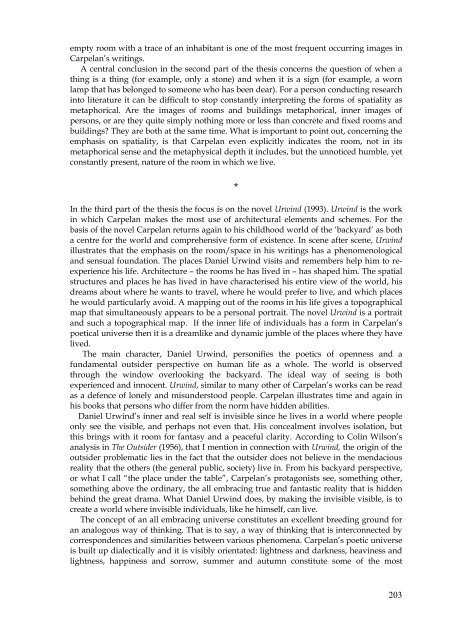Create successful ePaper yourself
Turn your PDF publications into a flip-book with our unique Google optimized e-Paper software.
empty room with a trace of an inhabitant is one of the most frequent occurring images in<br />
Carpelan’s writings.<br />
A central conclusion in the second part of the thesis concerns the question of when a<br />
thing is a thing (for example, only a stone) and when it is a sign (for example, a worn<br />
lamp that has belonged to someone who has been dear). For a person conducting research<br />
into literature it can be difficult to stop constantly interpreting the forms of spatiality as<br />
metaphorical. Are the images of rooms and buildings metaphorical, inner images of<br />
persons, or are they quite simply nothing more or less than concrete and fixed rooms and<br />
buildings? They are both at the same time. What is important to point out, concerning the<br />
emphasis on spatiality, is that Carpelan even explicitly indicates the room, not in its<br />
metaphorical sense and the metaphysical depth it includes, but the unnoticed humble, yet<br />
constantly present, nature of the room in which we live.<br />
*<br />
In the third part of the thesis the focus is on the novel Urwind (1993). Urwind is the work<br />
in which Carpelan makes the most use of architectural elements and schemes. For the<br />
basis of the novel Carpelan returns again to his childhood world of the ‘backyard’ as both<br />
a centre for the world and comprehensive form of existence. In scene after scene, Urwind<br />
illustrates that the emphasis on the room/space in his writings has a phenomenological<br />
and sensual foundation. The places Daniel Urwind visits and remembers help him to reexperience<br />
his life. Architecture – the rooms he has lived in – has shaped him. The spatial<br />
structures and places he has lived in have characterised his entire view of the world, his<br />
dreams about where he wants to travel, where he would prefer to live, and which places<br />
he would particularly avoid. A mapping out of the rooms in his life gives a topographical<br />
map that simultaneously appears to be a personal portrait. The novel Urwind is a portrait<br />
and such a topographical map. If the inner life of individuals has a form in Carpelan’s<br />
poetical universe then it is a dreamlike and dynamic jumble of the places where they have<br />
lived.<br />
The main character, Daniel Urwind, personifies the poetics of openness and a<br />
fundamental outsider perspective on human life as a whole. The world is observed<br />
through the window overlooking the backyard. The ideal way of seeing is both<br />
experienced and innocent. Urwind, similar to many other of Carpelan’s works can be read<br />
as a defence of lonely and misunderstood people. Carpelan illustrates time and again in<br />
his books that persons who differ from the norm have hidden abilities.<br />
Daniel Urwind’s inner and real self is invisible since he lives in a world where people<br />
only see the visible, and perhaps not even that. His concealment involves isolation, but<br />
this brings with it room for fantasy and a peaceful clarity. According to Colin Wilson’s<br />
analysis in The Outsider (1956), that I mention in connection with Urwind, the origin of the<br />
outsider problematic lies in the fact that the outsider does not believe in the mendacious<br />
reality that the others (the general public, society) live in. From his backyard perspective,<br />
or what I call “the place under the table”, Carpelan’s protagonists see, something other,<br />
something above the ordinary, the all embracing true and fantastic reality that is hidden<br />
behind the great drama. What Daniel Urwind does, by making the invisible visible, is to<br />
create a world where invisible individuals, like he himself, can live.<br />
The concept of an all embracing universe constitutes an excellent breeding ground for<br />
an analogous way of thinking. That is to say, a way of thinking that is interconnected by<br />
correspondences and similarities between various phenomena. Carpelan’s poetic universe<br />
is built up dialectically and it is visibly orientated: lightness and darkness, heaviness and<br />
lightness, happiness and sorrow, summer and autumn constitute some of the most<br />
203

















